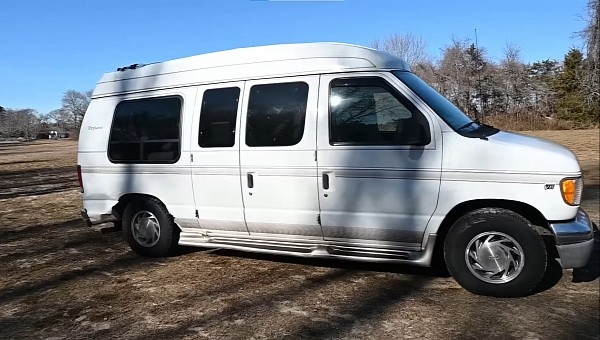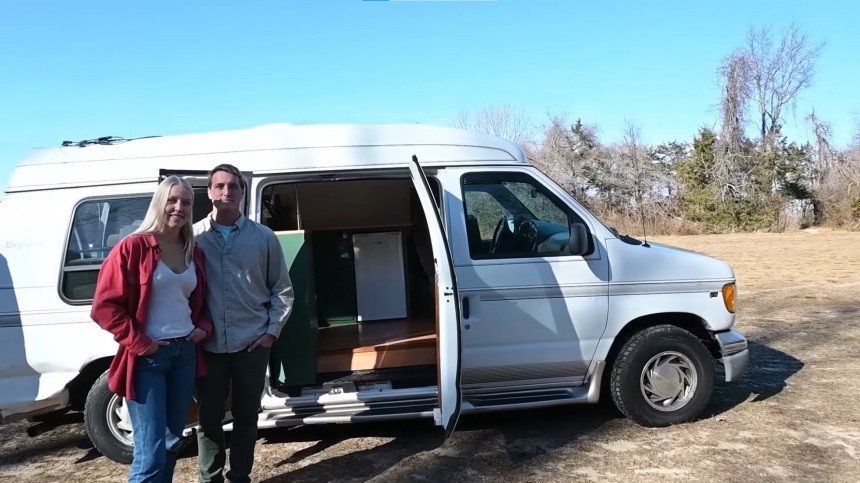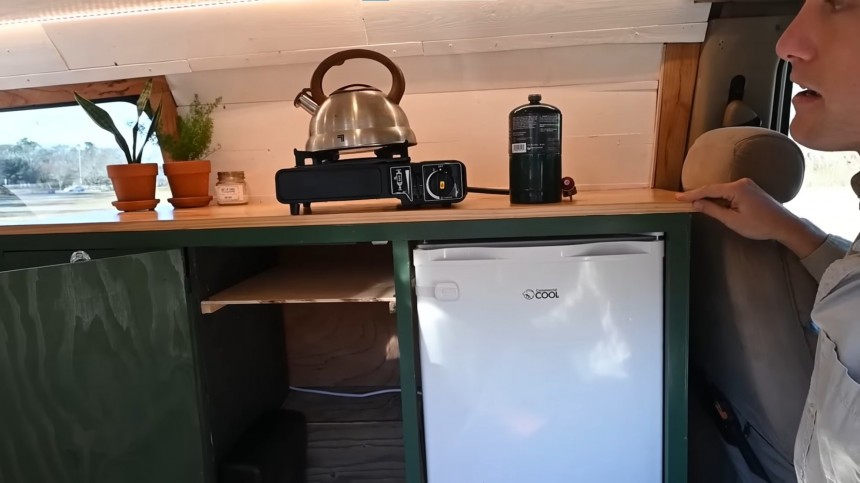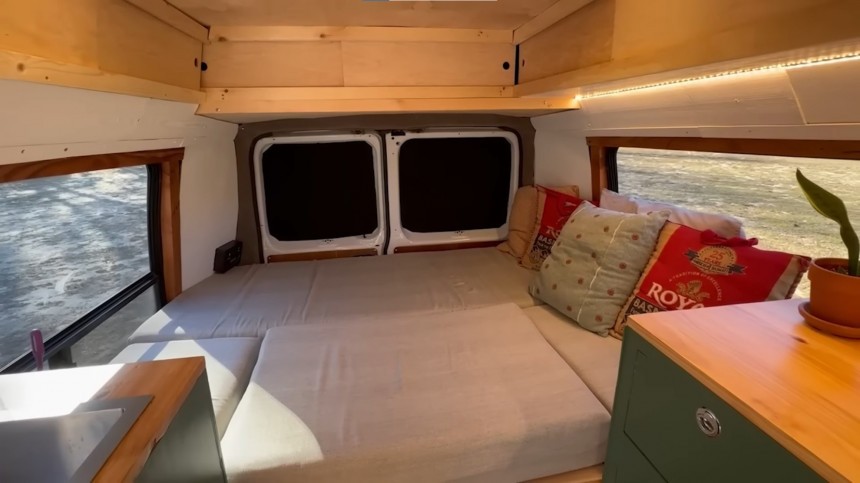Although the camper lifestyle appeals to some people, they are often discouraged by the high costs of buying or transforming a vehicle into a mobile home. However, I’d like to show you that a budget-friendly approach is possible, and it doesn’t mean you have to sacrifice the comforts you’ve gotten used to entirely. Today, I’m looking at a conversion van that didn’t empty the pockets of its owners, and maybe it’ll inspire you to start a journey of your own.
John and Ina are the owners and creators of this custom van, and we get to see the result of their conversion props to the New Jersey Outdoor Adventures YouTube channel. It’s a 2001 Ford Econoline E150 hi-top, a relatively popular choice among van-dwellers. The duo already had some experience with custom projects, as they completed a shuttle bus conversion last year, which they ended up selling.
A custom conversion can be a great way to build your ideal mobile home. Although it’s easier said than done. You can design your own space. And it’s way cheaper than buying an already-finished vehicle. It does require specific skills and need to dedicate time and energy. But in the end, I believe it can be worth it.
If you were to take a look at the van’s exterior, there isn’t any element that gives away its camper identity. The Ford had already been converted into a camper vehicle when the couple bought it. But the first step toward fulfilling their vision was to strip down its interior to bare metal.
Before we go any further to discuss the interior, I’d like to mention the price of this entire build, so you can understand that conversions can be made on a budget, and they can turn out really well. John and Ina spent $3,000 (€2,800) for the Ford Van – it’s equipped with a 4.6-liter engine, and its odometer reads a relatively low 118,000 miles (almost 190,000 km). John explains several benefits of driving the Ford: it has a decent fuel economy of 18-20 mpg (11.7-13 l/100 km) and can tow about 7,000-8,000 pounds (3,175-3,628 kg). What’s more, it features a passenger seat and fits in any size parking lot.
John and Ina invested an additional $5,000 (€ 4,664) for the systems and materials, bringing the total price to just $8,000 (€7,463). Let’s see the features of this conversion – it’s up to you to decide if the couple nailed this setup.
The duo used plywood for insulation and added hardwood flooring; this van has a lot of wooden elements, which isn’t a surprise. The first thing you notice when you enter is the kitchen, which features some cabinets and a small fridge. Given the interior’s reduced size, the couple had to compromise and use essential equipment. For instance, they have a tea kettle and a portable gas burner connected to a small canister. It’s a downgrade from their previous build, which had an oven installed into the countertop, but it does the job.
The couple took it upon themselves to build the cabinets and drawers, saving some money. I like the green paint finish, and they came up with simple yet effective solutions to keep everything locked in place, such as a baby lock and sailboat latches.
Just by the door, there’s a deep sink with a large and extendable faucet – it can be used outside if needed. The water system is also very straightforward – it comprises a water pump and two canisters, one for fresh water and one for grey water. This way, they can easily remove the latter and dump the grey water in a permitted area or empty it through the bottom of the van if they’re camping in nature.
Let’s move on toward the rear - there are two small seats with cushions and a swivel table between them. To transform the space into a bedroom, the couple must remove the table’s leg, put the remaining wooden plank between the seats, and cover it with a cushion. By the way, Ina made the cushions using a memory foam mattress and sowing the covers, which are also removable for washing.
John explained that the fridge is the only appliance running on 110 V, and the rest of the van uses 12 V. About that, there are two 100 Ah batteries, a 500 W inverter, and 400 W solar panels - a simple setup but more than enough for this vehicle.
Regarding storage, there are some tight spaces beneath the seat cushions, but they’re partly taken up by the wheel well in one place and the electrical system in the other. So, Jack and Ina built two spacious drawers under the bed, accessible from the rear. They also double as an outdoor cooking space.
This is an excellent build for a meager price of $8,000. It might not be the most well-equipped or comfortable setup, but it’s simple and efficient. The couple announced they plan on selling it, moving to Norway, and maybe starting a van life business there. Best of luck to Jack and Ina, and I hope you got some ideas from this DIY van conversion.
A custom conversion can be a great way to build your ideal mobile home. Although it’s easier said than done. You can design your own space. And it’s way cheaper than buying an already-finished vehicle. It does require specific skills and need to dedicate time and energy. But in the end, I believe it can be worth it.
If you were to take a look at the van’s exterior, there isn’t any element that gives away its camper identity. The Ford had already been converted into a camper vehicle when the couple bought it. But the first step toward fulfilling their vision was to strip down its interior to bare metal.
John and Ina invested an additional $5,000 (€ 4,664) for the systems and materials, bringing the total price to just $8,000 (€7,463). Let’s see the features of this conversion – it’s up to you to decide if the couple nailed this setup.
The duo used plywood for insulation and added hardwood flooring; this van has a lot of wooden elements, which isn’t a surprise. The first thing you notice when you enter is the kitchen, which features some cabinets and a small fridge. Given the interior’s reduced size, the couple had to compromise and use essential equipment. For instance, they have a tea kettle and a portable gas burner connected to a small canister. It’s a downgrade from their previous build, which had an oven installed into the countertop, but it does the job.
Just by the door, there’s a deep sink with a large and extendable faucet – it can be used outside if needed. The water system is also very straightforward – it comprises a water pump and two canisters, one for fresh water and one for grey water. This way, they can easily remove the latter and dump the grey water in a permitted area or empty it through the bottom of the van if they’re camping in nature.
Let’s move on toward the rear - there are two small seats with cushions and a swivel table between them. To transform the space into a bedroom, the couple must remove the table’s leg, put the remaining wooden plank between the seats, and cover it with a cushion. By the way, Ina made the cushions using a memory foam mattress and sowing the covers, which are also removable for washing.
Regarding storage, there are some tight spaces beneath the seat cushions, but they’re partly taken up by the wheel well in one place and the electrical system in the other. So, Jack and Ina built two spacious drawers under the bed, accessible from the rear. They also double as an outdoor cooking space.
This is an excellent build for a meager price of $8,000. It might not be the most well-equipped or comfortable setup, but it’s simple and efficient. The couple announced they plan on selling it, moving to Norway, and maybe starting a van life business there. Best of luck to Jack and Ina, and I hope you got some ideas from this DIY van conversion.


















